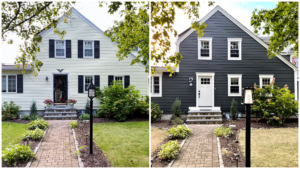

President at Plum ProExteriors
How to Paint Vinyl Siding in 7 Steps

A facade finished with siding looks neat and aesthetically pleasing. At the same time, such material is durable, not afraid of aggressive environmental factors, and easy to install. But often, vinyl siding needs to be painted. How to paint house siding correctly? In this article, we prepared a guide with seven steps to do this like a pro.
From assessing the condition of the siding and selecting the right paint to following recommendations for siding drying, each step is vital to ensure a successful paint job. So, let’s discover these stages in detail.
Vinyl siding: the reasons for painting
The siding is part of a ventilated facade (hinged). This means that the facade material is affixed to the wall indirectly, allowing for a ventilated space between them.

Vinyl siding is a popular cladding material for low-rise buildings due to many advantages. It is durable and inexpensive, and it can be easily repaired by replacing unnecessary facade fragments with new ones. The wide range of building materials on the market also determines the material’s availability.
But there is one drawback – color fading in the sun. The material is very susceptible to the effects of V-rays and loses its structural and color chain from prolonged (years) exposure to the sun, which is why it fades.
So, what are the main reasons to paint over vinyl siding? In general, there are two of them:
- Refreshing the condition of material: The obvious reason to repaint siding is wear and tear. After a long time, the finish begins to change and becomes dull, and pale spots and cracks are likely to appear. It seems clear that the problem of siding fading is not only aesthetic. We are talking about the integrity of the material’s structure itself. Timely painting will help protect the siding from possible damage in the future.
- Change of decor: The color range in the siding sales department will satisfy the needs of any buyer focused on this material. This problem cannot be solved by completely replacing the siding. A new facade will be expensive, so you can make it new, but buying exterior paint is the most realistic and affordable way. It will be cheaper, but the effect will be the same.
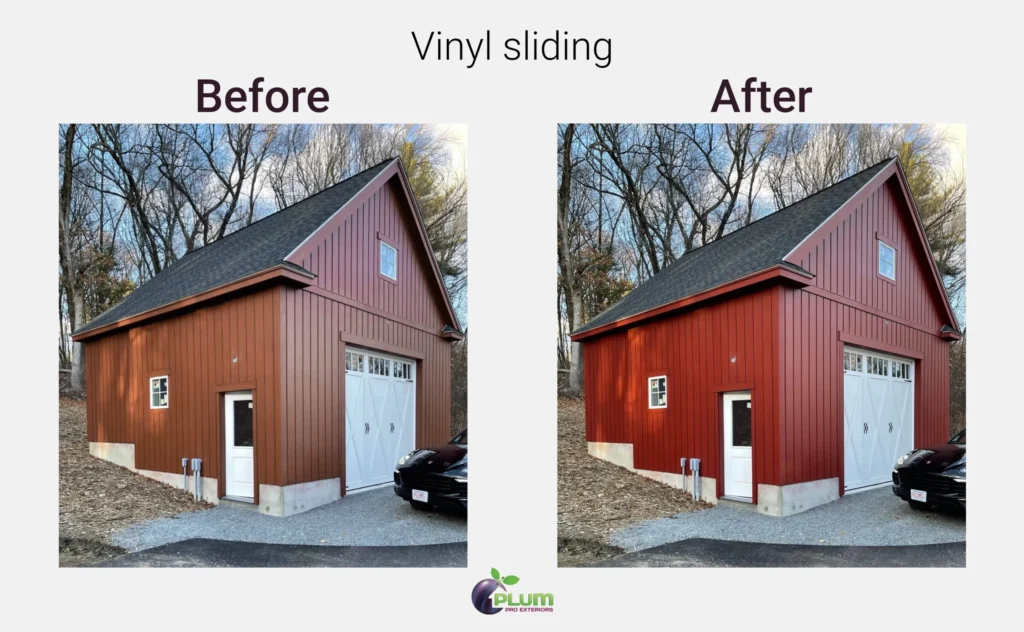
It is essential to consider the cost of refreshing your home. The expenses involved in replacing your siding can escalate quickly, often surpassing the cost of purchasing primer and vinyl siding paint. When your siding is still in good condition and well within its anticipated lifespan, it is a logical choice to opt for a paint refresh to save on costs.
With one gallon of paint covering approximately 400 sq. ft., even factoring in the possibility of applying two coats to a 2,000 sq. ft. house, the overall expense remains significantly lower compared to a complete siding replacement. This is another reason to choose vinyl siding painting.
7 steps to professionally paint for vinyl siding
Painting for vinyl siding can give your house a fresh and modern look and protect it from natural forces. How to paint vinyl siding? Following the steps for a successful paint job that lasts is essential.
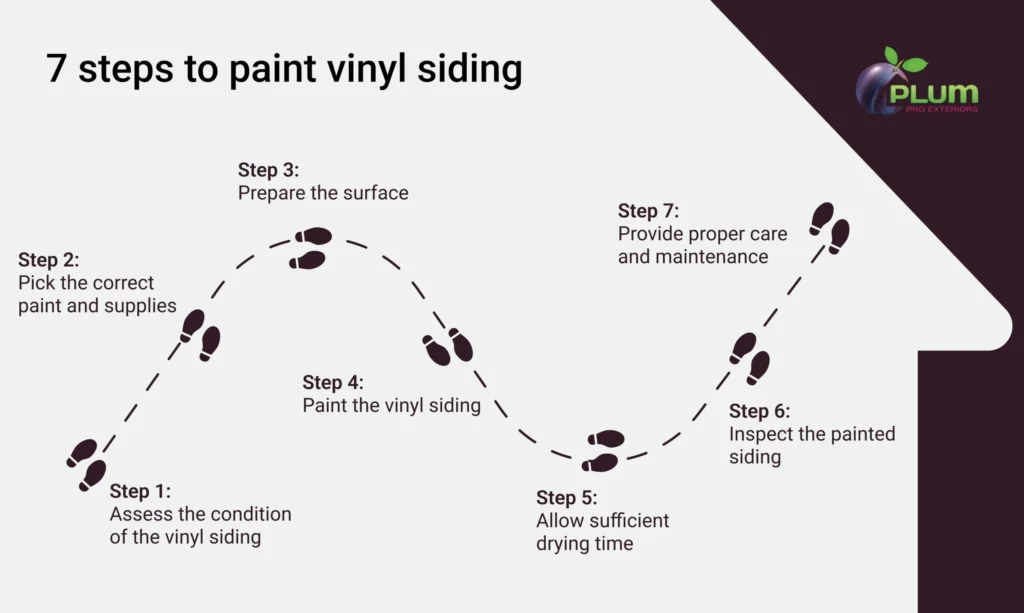
Step 1: Assess the condition of the vinyl siding
Before you begin to paint for vinyl siding, inspect that the vinyl siding is prepared for painting. Here’s how to go about it:
- Check for damages: Examine the siding meticulously for any signs of damage like cracks, chips, or dents. These flaws could affect how well the paint goes and the final look of the surface.
- Look out for mold or mildew: Inspect the siding for any areas where mold or mildew might be lurking. Not only do these growths mar the appearance, but they can also undermine the paint’s durability if left untreated.
- Evaluate cleanliness: Determine whether the siding is clean or if it needs a thorough washing to remove dirt, grime, or other contaminants. A clean surface is required for optimal adhesion of a paint and a smooth finish.
- Identify repair areas: Take note of any sections requiring repair or maintenance before painting. This may involve filling in cracks, replacing damaged portions of the siding, or addressing underlying issues such as water damage.
Step 2: Pick the correct paint and supplies
For a successful outcome of the painting, it is vital to pick the appropriate paint and supplies to ensure the paint job’s longevity and durability.
The proper paint
When you ask, “Can you paint over vinyl siding?” consider the paints’ importance. Vinyl siding can only be treated with the following paint mixtures to achieve the effect:
- Natural acrylic mixtures: They should be of 100% concentration. Urethane acrylic is used with them.
- Latex compounds: They are used in rainy cities; for hot climate zones, such protection will be questionable, and a stronger paint mixture will be required.
- Industrial coatings from plastic processing products: The first thing you must know about this type is that they may not meet material safety requirements. As this is a waste product, it may contain toxic fumes which should never be inhaled. Therefore, you should only buy paints that are approved by GOSTs and have certificates.
- Specialized paint compositions: Here, the store’s sales consultant will be able to help you choose and will suggest the type of mixture that will meet the climatic conditions of the city.
Necessary materials and tools
The best way to paint vinyl siding is to equip yourself with the right painting tools and materials, which we have listed in the table below.
| Tools | Materials |
|---|---|
| Garden hose with spray nozzle for cleaning | Quality vinyl-safe primer (optional) |
| Ladder | TSP (trisodium phosphate) to tackle grime or mildew |
| Pressure washer (optional) | Painter’s tape |
| Soft-bristled brush for scrubbing | Plastic sheeting |
| Paintbrush for touch-ups | Quality acrylic paint for vinyl siding and vinyl-safe colors |
| Paint roller or paint sprayer for application | Cleaning solution |
Step 3: Prepare the surface
To proceed to the primary stage of how to paint plastic siding, you should ensure your siding is ready for painting and lays the groundwork for its flawless application. Here are step-by-step actions before starting painting:
Keep the siding clean
- Clean the surface: Combine powdered laundry detergent, household cleaner, and a dash of bleach in the water to concoct a potent mixture. Thus, you can eradicate dirt, mildew, and grime from your siding.
- Use soft cleansing: Employ a soft-bristled brush to scrub the siding delicately with the cleaning solution. Gentle strokes ensure thorough cleansing without risking damage to the vinyl surface.
- Conduct thorough rinse: After the scrubbing session, give your siding a thorough rinse using clean water from a garden hose, ensuring no traces of cleaning solutions or loosened dirt linger behind.
Rehabilitation of imperfections
Vigilant inspection is another vital aspect of painting the siding correctly. It is crucial to identify and rectify any imperfections on the surface. Check your siding meticulously for telltale signs of damage, such as cracks, warping, or brittleness in the vinyl. When necessary, replace any damaged sections of the siding before commencing with the painting endeavor. This step lays the groundwork for a seamlessly uniform finish.
Here are some tips for addressing common issues like cracks, chips, or mold on vinyl siding:
- Cracks and chips: Use a high-quality vinyl siding repair kit to fill in cracks and chips. Follow the manufacturer’s instructions carefully and ensure that the repaired areas are smooth and level before painting exterior vinyl siding.
- Mold and mildew: To tackle mildew and mold growth, clean the affected areas with a vinyl siding cleaner or a mixture of water and mild detergent. For stubborn mold stains, use a solution of bleach diluted with water. Scrub the surface gently with a soft-bristled brush, then wash it off with water. Wait for the siding to dry before proceeding with painting.
- Preventive measures: To prevent future issues with cracks, chips, or mold, consider taking proactive measures such as regularly cleaning the siding, maintaining proper ventilation to prevent moisture buildup, and promptly addressing any damage or signs of deterioration.
- Professional assistance: If you’re unsure about tackling repairs yourself or if the damage is extensive, consider seeking professional assistance from a reputable siding contractor. They will assess the condition of the siding, recommend appropriate repair solutions, and ensure that the surface is ready for painting.
Strategic shielding of untouched areas
Preserving areas untouched by paint requires precision and foresight. Employ painter’s tape to meticulously outline windows, doors, and trim, safeguarding them from accidental paint splatters. Lay down drop cloths or plastic sheeting to shield surrounding landscapes and adjacent surfaces from potential drips or overspray, ensuring a pristine finish for your home’s exterior.
Now your façade is ready to be painted, let’s look at the next steps.
Step 4: Paint the vinyl siding
To begin painting your vinyl siding correctly, you need the perfect combination of favorable conditions, quality materials, and skilled techniques. Follow these steps to guarantee not only a visually stunning paint job but also one that endures the test of time.
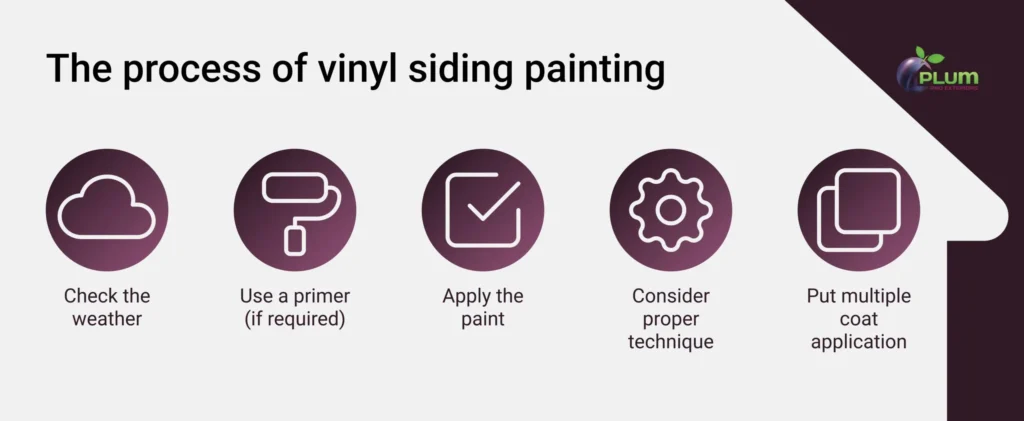
Check the weather
The success of painting vinyl siding hinges greatly on weather patterns. Seek optimal conditions, such as low humidity, mild temperatures between 50°F and 85°F, and cloudy skies. These conditions prevent premature or uneven drying of the paint. Make sure there’s no rain forecasted on the painting day and for at least 24 hours afterward to ensure the paint fully dries.
Use a primer (if required)
While not always mandatory, primer application can be pivotal depending on the state of your siding. Applying a primer can optimize paint adhesion and coverage if your vinyl siding displays severe fading or discoloration.
Apply the paint
Correct paint application is essential for achieving a flawless finish and long-lasting outcomes. Utilize a paint sprayer for extensive coverage and even distribution, particularly across larger surfaces. For intricate areas or smaller sections, employ a roller or brush.
Consider proper technique
Apply paint in thin, uniform coats. Make sure each coat is dried according to the manufacturer’s recommendations before proceeding to the next. This ensures superior adhesion and durability.
Put multiple coat application
We recommend applying two coats to attain the utmost finish and protection. This will ensure consistent color saturation and comprehensive siding protection. Each coat should dry thoroughly before applying the next one. Drying times may range relating on weather conditions and the paint product utilized.
With meticulous preparation, quality materials, and precise execution, your residence will boast a fresh and inviting exterior.
Step 5: Allow sufficient drying time
This is the next step in our guide on how to paint house siding. After applying the paint, it’s crucial to allow for adequate drying time to achieve optimal results and durability. Here’s how to ensure your vinyl siding dries effectively:
- Follow manufacturer’s instructions: Different paints may have varying drying times, so it’s essential to adhere to the instructions provided by the manufacturer. Thus, you will know how long to wait between coats and when the paint is fully cured.
- Consider the weather conditions: Weather conditions can significantly impact drying time. Ideally, pick a day with moderate temperatures and low humidity for painting. Additionally, avoid painting on windy days to prevent debris and dust from sticking to the wet paint.
- Don’t hurry up: Resist the urge to touch or disturb the painted surface before it’s fully dry. The paint may feel dry to the touch, but it’s essential to allow it to cure completely to ensure maximum durability.
- Test before proceeding: Before applying additional coats or allowing regular activities near the painted surface, perform a touch test in an inconspicuous area. If the paint feels tacky or soft, it’s not fully cured, and additional drying time is necessary.
- Plan accordingly: Factor in the drying time when painting a vinyl house. Depending on the environmental conditions and types of paints, drying times can range from a few hours to several days. Be patient and allow sufficient time for each coat to dry before going to the next step.
Ensure the appropriate drying time to achieve a flawless finish and prolong the lifespan of your vinyl siding paint job.
Step 6: Inspect the painted siding
After allowing sufficient drying time, it’s time to inspect your freshly painted vinyl siding. Ensure your paint job meets your expectations by following the steps below:
- Visual inspection: Take a close look at the entire surface of the siding. Look for any inconsistencies, streaks, or areas where the paint may not have adhered correctly.
- Touch test: Gently touch various areas of the siding to ensure the paint is dry to the touch. Avoid pressing too hard to prevent leaving fingerprints or indentations.
- Check for uniformity: Assess the overall appearance of the siding to be confident that the paint has been applied evenly. Look for any spots that may need additional coats or touch-ups.
- Addressing imperfections: If you notice any imperfections or areas that need improvement, mark them for touch-up or further attention. Use a roller or a small brush to fix any issues promptly.
- Final walkaround: Take a final walkaround to ensure you haven’t missed any spots. Pay attention to corners, edges, and trim areas where paint may be thinner or less evenly applied.
By inspecting your painted vinyl siding, you can address any issues promptly and receive a perfect result.
Step 7: Provide proper care and maintenance
Here are effective strategies to uphold the pristine appearance of your recently painted siding:
- Conduct routine cleaning: Regularly wash your siding using a mild detergent solution and a soft brush to eliminate dirt without harming the paint. Opt for gentle cleaning annually or semi-annually to maintain its allure.
- Avoid pressure washing: Avoid the temptation of using a pressure washer on painted vinyl siding, as it can potentially remove the paint. If necessary, utilize the lowest pressure setting and maintain a suitable distance from the surface.
- Provide thorough inspections: Conduct visual inspections twice a year to identify any signs of damage like chips, cracks, or peeling. Promptly fix any imperfections to prevent further deterioration, utilizing leftover paint for touch-ups.
- Heat management: Given vinyl siding’s susceptibility to temperature fluctuations, mitigate heat exposure by incorporating landscaping elements that provide shade. Additionally, opt for lighter paint colors to minimize heat absorption during future painting endeavors.
Implementing these maintenance techniques ensures that homeowners preserve the allure and integrity of their painted vinyl siding for an extended period.
Cases when is it worth replacing siding instead of painting
If you reach out to the service provider with the request to paint vinyl siding, be ready that there are several cases when a painting does not make any sense:
- The finish is several decades old, and its mechanical and technical properties are no longer in the same condition as before.
- There are many bulges, cracks, chips, or waves on the surface.
In such obstacles, you will have to replace the finishing material. In all other cases, painting over vinyl siding is a good option for updating the facade. The main thing is to pick the right paint and approach the procedure correctly. This will transform the appearance of your home, making it bright and fresh.
Bonus: exterior trendy colors for 2024
It is a bonus section in our guide on how to paint house siding. We know that choosing the right colors of paint is one of the most important steps to be satisfied with the final results.
The latest trends in exterior paint colors are pushing boundaries. They combine the boldness of using dark shades, vibrant whites, and intriguing color combinations. Here are some of the top trends for this year for painting vinyl siding.
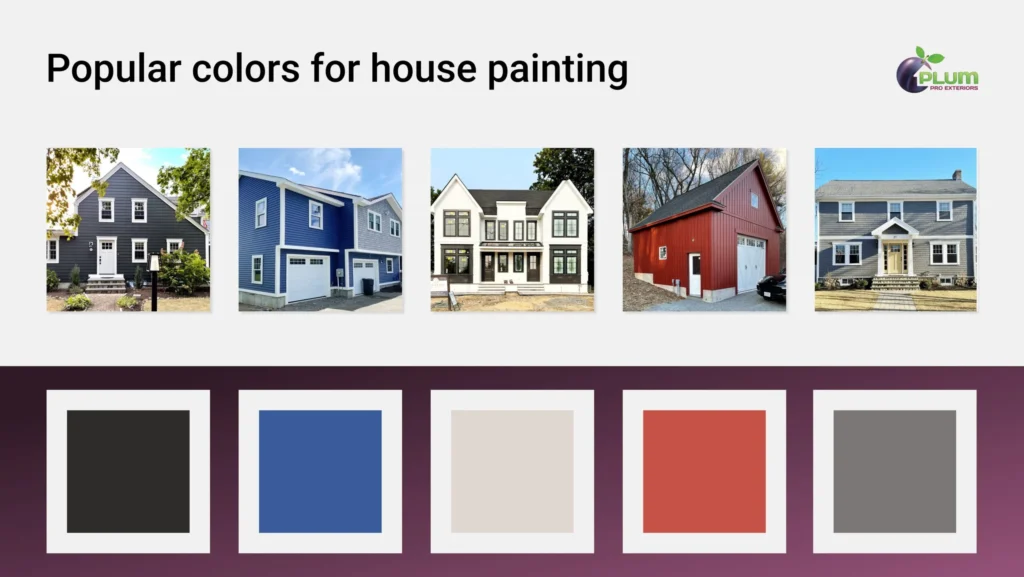
Contrasting light and dark tones
Neutral hues are taking a backseat as homeowners opt for striking contrasts. Dark navy blue siding paired with crisp white trim and deep-toned roofs create a captivating visual impact. This dynamic interplay between dark and light elements adds depth and character to your home’s exterior, ensuring it stands out from the crowd.
Earthy palettes
Applying earthy tones such as browns, greens, and reds lends a natural charm to your home, seamlessly blending with the surrounding landscape. These warm and inviting hues allow for playful yet understated color schemes, infusing your exterior with a sense of harmony and tranquility.
Revival of beige
Beige makes a comeback with a modern twist, featuring shades that exude warmth while remaining neutral. Pairing these deeper beige hues with crisp white trim creates a timeless contrast that enhances the architectural details of your home.
Elegance of black
The popularity of black continues to soar, adding sophistication and allure to any exterior. Whether used as a primary color or as an accent, black creates a striking visual impact that sets your home apart. Its versatility enables seamless integration with a variety of accent colors, ensuring a timeless and refined aesthetic that transcends trends.
Conclusion
Painting vinyl siding is a great option to modernize the appearance of your home while protecting the materials from environmental elements. With the right preparation, materials, and techniques, anyone can achieve good results and enjoy the benefits of a beautifully painted exterior.
It is possible to paint vinyl siding yourself, but the process will be much smoother and faster with a professional team. If you are searching for a reliable partner to enhance the look of your house, turn to us. The Plum ProExteriors company provides budget-friendly and effective services, and we are always eager to help you with any request for siding, roofing, and more.



